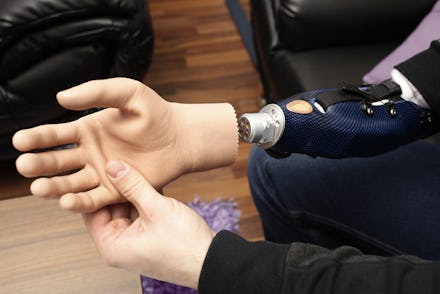Scientists Are Working to Take Cyborg Technology to the Next Level

Today, an Italian surgeon recruits medical professionals to work on the first ever full head transplant. A professor walks to his lab on two bionic legs to create new technologies that could eliminate disabilities. A blind man sees with the power of an electronic eye connected to his brain.
All of these are possible through cyborg technology, traditionally defined as a way to enhance human capability by artificial means. This kind of restorative cyborg tech is enhancing people's lives by replacing natural human capabilities with artificial ones, reviving injured, disabled or sick people back to full health.
"Fifty years out, I think we will have largely eliminated disability," Hugh Herr, who leads the biomechatronics lab at MIT, told Spectrum.
While restorative cyborg technology is already helping patients in many life-changing ways, there is one main hurdle preventing humans from seamlessly integrating with them — the material of the technology itself.
"The problem with doing stuff in metal is that the rate at which tech changes is much faster than the rate at which it is convenient to install hardware in your body," Tim Maly, an industrial design lecturer at the Rhode Island School of Design and a Harvard Metalab fellow, told Mic. "A lot of the mechanical stuff will fall away and be replaced by things that will more easily integrate into the human body."
Instead of using an artificial material like metal or plastic, scientists are trying to replicate human flesh itself. Tissue engineering is an emerging discipline focused on figuring out how to develop new human tissues from scratch, in order to replace failed organs, skin and more.
"This is regenerative medicine," Amber Case, a cyborg anthropologist and founder of CyborgCamp, told Mic. "It's a new group of body parts, so you don't rely on the limited supply of real people."
In 2012, a team of bioengineers at Harvard University created the first cyborg tissue. This tissue combined cells with thin nanowires, allowing the scientists to monitor impulses inside of the body. While those tissues weren't used to heal an injury, this development is one step towards creating real regenerative tissue from scratch.
This kind of regenerative tissue could become a reality if scientists develop a medical 3-D printer to create it — and they're now working to do just that. A number of trials and experiments are in the field, and at Wake Forest University's Institute for Regenerative Medicine, researchers have created prototypes of small organs and tissues made from 3-D printers.
Case believes 3-D printing regenerative tissue and organs could save money, time and human lives. Right now, if someone needs an organ transplant, they are placed on a long wait list, where they're at risk of death or organ failure before a transplant comes through. 3-D printing new organs could eliminate these risks.
"It's a new group of body parts so you don't rely on the limited supply of real people," Case said.
Cyborg medical technology has the potential to give people a normal quality of life despite injury and illness. It's already starting to help a number of people, but the day when this technology can truly replicate natural human body parts remains a far distant goal.
This story was written by Mic's branded content team with no involvement from Mic's editorial staff. Today's advancements in AI draw a parallel theme to Skynet, the artificial intelligence software in Terminator Genisys that leads to Judgement Day. When John Connor sends Sgt. Kyle Reese back to 1984 to protect Sarah Connor and safeguard the future, he finds himself in a new and unfamiliar version of the past. He is faced with a new T-800 terminator (Arnold Schwarzenegger), new enemies, and a new mission: To reset the future...Terminator Genisys is in theatres July 1st.